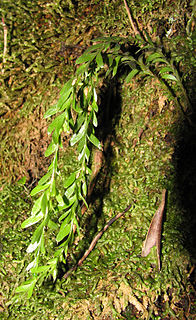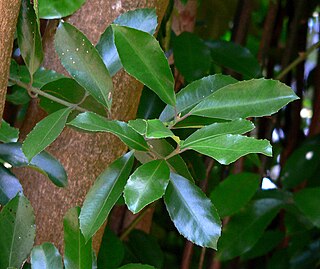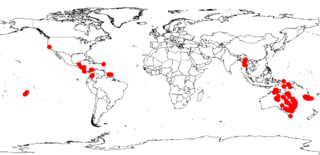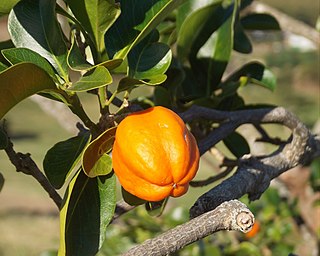
Dysoxylum is a flowering plant genus of trees and shrubs from the mahogany family, Meliaceae.

Elattostachys is a genus of about 21 species of trees known to science, constituting part of the plant family Sapindaceae.

Tmesipteris, the hanging fork ferns, is a genus of ferns, one of two genera in the family Psilotaceae, order Psilotales . Tmesipteris is restricted to certain lands in the Southern Pacific, notably Australia, New Zealand and New Caledonia. In New Zealand this hanging epiphyte is common in the warm temperate rain forests of both main islands, where it can normally be found as short spiky dark-green fronds, often with lighter bag-like sporangia at the bases of some of its "leaves". The plant possesses no true leaves; what appear to be leaves are flattened stems. The fronds emerge directly from the fibrous root-mats which clad the trunks of mature tree ferns such as Dicksonia and Cyathea. Tmesipteris is from the Greek language, meaning a "cut fern", referring to the truncated leaf tips.

Geissois is a genus of trees and shrubs in the plant family Cunoniaceae. It includes about 19 species mostly found in New Caledonia, but also in Fiji, Vanuatu, and the Solomon Islands. Leaves are opposite, palmate with 3-9 leaflets, with entire margin and intrapetiolar stipules. The inflorescences are simple racemes and bottle-brush like. The flowers have four red sepals, lacking petals, with many long red stamens. The fruit is a capsule, the seeds flat and winged. The genus includes several nickel hyperaccumulator and one aluminum hyperaccumulator, Geissois polyphylla.

Pancheria is a genus of shrubs and trees in the family Cunoniaceae. It is to endemic to New Caledonia and contains 27 species. Leaves or whorled, simple or pinnate. The flowers are arranged in capitula, fruits are follicular. The species are dioecious. The genus is well diversified on ultramafic rocks and some species are nickel hyperaccumulators. It is related to Cunonia and Weinmannia. It was named after Jean Armand Isidore Pancher.

Cunonia is a genus of shrubs and trees in the family Cunoniaceae. The genus has a disjunct distribution, with 24 species endemic to New Caledonia in the Pacific, and one species in Southern Africa. Leaves are opposite, simple or pinnate with a margin entire to serrate. Interpetiolar stipules are often conspicuous and generally enclose buds to form a spoon-like shape. Flowers are bisexual, white, red, or green, arranged in racemes. The fruit is a capsule opening first around the base then vertically, seeds are winged.
Grevillea exul is a species of flowering plant in the family Proteacae, endemic to New Caledonia.

Hedycarya is a genus of dioecious trees and shrubs of the family Monimiaceae. Species occur in South East Asia, New Caledonia, Australia and Polynesia including New Zealand. The genus was named and formerly described in 1776 by botanists Johann and Georg Forster in Characteres Generum Plantarum. The limit of the genus may require change as it appears paraphyletic in phylogenetic analyses, with the genera Kibaropsis and Levieria nested in it.

Trochocarpa is a genus of shrubs or small trees, of the plant family Ericaceae. They occur naturally through coastal and montane eastern Australian rainforests and mountain shrublands and in New Guinea, Borneo and Sulawesi (Malesia).
Bulbophyllum keekee is a species of orchid in the genus Bulbophyllum, native to New Caledonia. It is protected in the northern province.

Stenocarpus umbelliferus is a species of flowering plant in the family Proteaceae. It is endemic to New Caledonia. It has a prostrate or upright habit, growing up to 5 metres in height. Stems are flattened when young, later becoming rounded. The leaves are thick and leathery with a slightly wavy margin. These may be ovate, elliptic, lanceolate or spathulate in shape with petioles that are 3 to 12 mm long. White, cream or pale yellow flowers occur in groups of 3 to 8 per umbel. These are followed by dark-coloured glabrous follicles that are 25 to 80 mm long and 3 to 5 mm wide.

Metrosideros operculata is a species of flowering plant in the family Myrtaceae. It is endemic to New Caledonia. It usually grows as a shrub to 3 metres in height, or rarely as a small tree to 10 metres. Stems are square in section and covered with silky hairs. The stiff, pointed leaves have a slightly revolute margin and are linear to elliptic in shape. They are 12 to 40 mm long and 3 to 10 mm wide. White, pink or red flowers with 3 petals and between 50 and 120 stamens are produced in axillary inflorescences.
Virotia is a genus of six species of flowering plants in the family Proteaceae. The genus is endemic to New Caledonia with six species that were once placed in Macadamia. Its closest relatives are the Australian Athertonia and the Asian Heliciopsis. The genus is named after Robert Virot, pioneer of ecological studies in New Caledonia and author of a monograph of New Caledonian Proteaceae.

Codia is a genus of trees and shrubs in the family Cunoniaceae. The genus is endemic to New Caledonia in the Pacific and contains 15 species. The leaves are opposite or whorled, simple, and the margin usually entire. The flowers are arranged in capitula. the ovary is inferior. The fruit is indehiscent and is covered with woolly hairs.

Deplanchea tetraphylla is a species of tropical rainforest tree, commonly known as golden bouquet tree, wallaby wireless tree or yellow pagoda flower tree, constituting part of the plant family Bignoniaceae.
Deplanchea bancana is a tree in the family Bignoniaceae. It is named for Sumatra's Bangka Island.

Geissois hirsuta is a tree species that is endemic to New Caledonia. It is known locally as geissois velu.
Bryan Alwyn Barlow is an Australian botanist. He was a member of Committee of the "Flora of Australia" 1982–1984, and 1986–1988. He is a former director of the Australian National Herbarium (1981-1988). He authored many Myrtaceae, Loranthaceae and Viscaceae species.

Hugh Shaw MacKee previously known as Hugh Shaw McKee was a botanist who was born in Northern Ireland, but who collected in Australia and Oceania, and finally in New Caledonia, where together with his wife and other collaborators, he collected over 46,000 specimens.

Fontainea pancheri is a small tree or shrub endemic to New Caledonia in the family, Euphorbiaceae, which grows to a height of 15 m.















